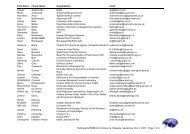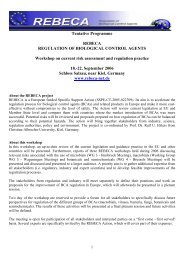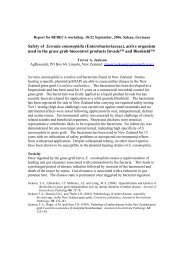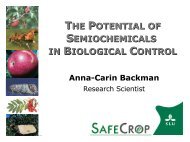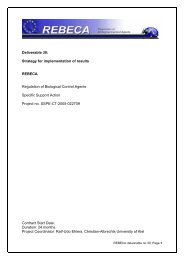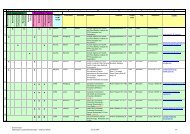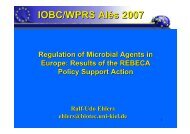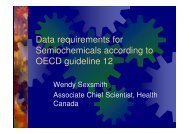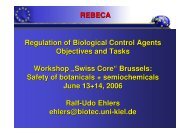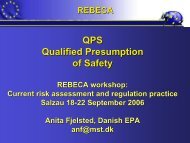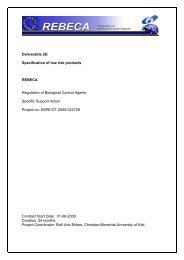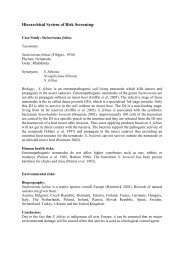EPA: Bacillus subtilis Strain QST 713 (006479) BRAD - REBECA
EPA: Bacillus subtilis Strain QST 713 (006479) BRAD - REBECA
EPA: Bacillus subtilis Strain QST 713 (006479) BRAD - REBECA
- No tags were found...
You also want an ePaper? Increase the reach of your titles
YUMPU automatically turns print PDFs into web optimized ePapers that Google loves.
<strong>EPA</strong>: <strong>Bacillus</strong> <strong>subtilis</strong> <strong>Strain</strong> <strong>QST</strong> <strong>713</strong> (<strong>006479</strong>) <strong>BRAD</strong>BIBLIOGRAPHYC. LabelingD. Data Necessary to Support aConditional RegistrationBIOPESTICIDE REGISTRATION ACTION TEAMI. EXECUTIVE SUMMARY<strong>Bacillus</strong> <strong>subtilis</strong> strain <strong>QST</strong> <strong>713</strong> as an active ingredient is a biological control agent for use on severalminor crops to treat a variety of plant diseases and fungal pathogens including gray mold, powderymildew, early and late blight, bacterial spot, and walnut blight. <strong>Bacillus</strong> <strong>subtilis</strong> is a ubiquitous bacteriacommonly found in various ecological niches including soil, water and air which does not have ahistory of pathogenicity from contact in the environment. In addition, there are other strains of B.<strong>subtilis</strong> which are registered as microbial pesticides.Sufficient data are available to determine that <strong>Bacillus</strong> <strong>subtilis</strong> strain <strong>QST</strong> <strong>713</strong> has low toxicity tomammals and is not expected to be pathogenic in humans. Standard personal protective equipmentare required to mitigate any risk to pesticide handlers and applicators. No significant risk is expectedfrom the terrestrial ground application of the end-use product to birds, fish, ladybird beetles, greenlacewings, honeybees, parasitic wasps, and aquatic invertebrates. Risks to honeybees have beenmitigated by requiring that the end-use product not be applied when bees are actively visiting thetreatment area and not allowing certain bee-sensitive crops (apples and pears) on the label.The data submitted to <strong>EPA</strong> on B. <strong>subtilis</strong> strain <strong>QST</strong> <strong>713</strong> are adequate to support a 2 year timelimitedconditional registration under FIFRA section 3(c)(7)(C). A whole hive honeybee study is beingrequired as a condition of registration. In addition as a term and condition of registration, the Agencyis requiring a specific manufacturing process including an analysis of each batch for particularmicrobial contaminants. Additional product characterization studies, including storage stability studieswill be required if the registrant applies to amend their registration to eliminate the requiredmanufacturing process and batch analysis. In addition, the Agency is requiring confirmatory data onsome ecological effects studies to further evaluate the pathogenicity potential of this strain of B.subtilus to non-target organisms.The acute oral toxicity, acute dermal toxicity, acute pulmonary, acute intravenous, primary eyeirritation, primary dermal irritation, and delayed contact hypersensitivity test are acceptable. Theacute pulmonary study showed no mortality and no adverse effects when performed using thetechnical product. There was also no mortality from the acute inhalation study using the end-useproduct although some clinical signs and weight loss were noted. However, the acute inhalation studydid not measure the actual concentration of the product in the test. Considering that the particle sizeof the wettable powder poses a low risk of inhalation exposure and the nature of the inerts in theproduct, the Agency is using the acute inhalation study as confirmatory of the acute pulmonary studyand waiving the requirement for a repeated acute inhalation study. In addition, any risk is mitigated bystandard personal protective equipment and the reentry interval required for the end-use product.Extremely high levels of the bacteria were used in the ecological effects testing. The levels farfile:///J|/<strong>REBECA</strong>/Meetings/1.%20Conference/<strong>REBECA</strong>%...up%20work%20bacteria%20fungi/epaprintonly.cgi.html (2 von 29)13.09.2006 18:40:13
<strong>EPA</strong>: <strong>Bacillus</strong> <strong>subtilis</strong> <strong>Strain</strong> <strong>QST</strong> <strong>713</strong> (<strong>006479</strong>) <strong>BRAD</strong>885.1300Formation ofUnintentionalIngredientsACCEPTABLEwhen themanufacturingprocess required by<strong>EPA</strong> is followed andthe required QA/QCis performed.44651904,45084501885.1400 Analysis of SamplesACCEPTABLEwhen themanufacturingprocess required by<strong>EPA</strong> is followed, therequired QA/QC isperformed, andeach batch is testedfor microbialcontamination.44651902885.1500 Certification of Limits ACCEPTABLE 45084501830.6302,830.6303,830.6304,830.7000,885.7300Product ChemistryACCEPTABLEexcept for StorageStability. Storagestability data areSUPPLEMENTALand may beupgraded withsubmission ofadditional data.4465190144651903Additional manufacturing process data are required as a condition ofregistration. Details concerning requirements are discussed in aConfidential Business Information Appendix.B. Human Risk Assessment1. Human Toxicity AssessmentThe acute oral toxicity, acute dermal toxicity, acute pulmonary, acute intravenous, primary eyeirritation, primary dermal irritation, and delayed contact hypersensitivity test are acceptable. Theacute pulmonary study showed no mortality and no adverse effects when performed using thetechnical product. There was also no mortality from the acute inhalation study using the end-useproduct although some clinical signs and weight loss were noted. However, the acute inhalation studydid not measure the actual concentration of the product in the test. Considering that the particle sizeof the wettable powder poses a low risk of inhalation exposure and the nature of the inerts in theproduct, the Agency is using the acute inhalation study as confirmatory of the acute pulmonary studyand waiving the requirement for a repeated acute inhalation study. In addition, any risk is mitigated byfile:///J|/<strong>REBECA</strong>/Meetings/1.%20Conference/<strong>REBECA</strong>%...up%20work%20bacteria%20fungi/epaprintonly.cgi.html (6 von 29)13.09.2006 18:40:13
<strong>EPA</strong>: <strong>Bacillus</strong> <strong>subtilis</strong> <strong>Strain</strong> <strong>QST</strong> <strong>713</strong> (<strong>006479</strong>) <strong>BRAD</strong>standard personal protective equipment and the reentry interval required for the end-use product.Table 2. Toxicity Data RequirementsOPPTSGUIDELINENUMBERSTUDY RESULT MRID#885.3050Acute OralToxicity/PathogenicityAcceptable, Toxicity Category IV44651906885.3100Acute DermalToxicity/PathogenicityLD 50 of <strong>QST</strong> <strong>713</strong> Technical in ratsis >2g /kg body weight.Acceptable, Toxicity Category III44651907885.3150AcutePulmonaryToxicity/PathogenicityAcceptable. No mortality and noadverse effects. The test microbewas detectable (both pre- and postheattreatments) in the lung throughDay 35, but at significantly reducedlevels compared to day 0.44651909Study considered confirmatory forthe acute pulmonary study. Someclinical signs and weight loss werenoted, but no mortality resulted fromdosing. The actual concentrationwas not determined.870.1300Acute Inhalation(End-UseProduct WP)Normally, particles the size of thosemeasured for <strong>QST</strong> <strong>713</strong> wettablepowder pose a low risk of inhalationexposure. Study results could beenhanced with analytical dataindicating the actual concentrationused in dosing.44652705Potential risk is mitigated byprotective clothing requirements ofa dust/mist filtering respirator andthe reentry interval.file:///J|/<strong>REBECA</strong>/Meetings/1.%20Conference/<strong>REBECA</strong>%...up%20work%20bacteria%20fungi/epaprintonly.cgi.html (7 von 29)13.09.2006 18:40:13
<strong>EPA</strong>: <strong>Bacillus</strong> <strong>subtilis</strong> <strong>Strain</strong> <strong>QST</strong> <strong>713</strong> (<strong>006479</strong>) <strong>BRAD</strong>885.3200AcuteIntravenousToxicity/PathogenicityAcceptable. No mortality and noadverse clinical signs in rats dosedwith <strong>QST</strong> <strong>713</strong> technical powder.The test microbe cleared from mostorgans by day 35; however, lowlevels detected in spleen and liverafter 35 days.44651908870.2400Primary EyeIrritationAcceptable, Toxicity Category III 44664602870.2500Primary DermalIrritationAcceptable, Toxicity Category IV 44664601870.2600DelayedContactHypersensitivityin Guinea Pigs(<strong>QST</strong> <strong>713</strong>WettablePowder)Acceptable - <strong>QST</strong> <strong>713</strong> WP productdid elicit a very mild delayedhypersensitivity response. Potentialdermal sensitizer446647052. Toxicological ProfileConsistent with section 408(b)(2)(D) of FFDCA, <strong>EPA</strong> has reviewed the available scientific data andother relevant information in support of this action and considered its validity, completeness, andreliability and the relationship of this information to human risk. <strong>EPA</strong> has also considered availableinformation concerning the variability of the sensitivities of major identifiable subgroups of consumers,including infants and children.A battery of tests determined that <strong>QST</strong> <strong>713</strong> Technical product is not pathogenic and has nosignificant toxicity. The acute oral toxicity/pathogenicity, acute pulmonary toxicity/pathogenicity, andacute intravenous toxicity/ pathogenicity studies demonstrated no significant toxicity and a lack ofpathogenicity. The dermal toxicity and eye irritation studies resulted in a Toxicity Category IIIclassification. The acute dermal irritation study resulted in a Toxicity Category IV classification.<strong>Bacillus</strong> <strong>subtilis</strong> is a ubiquitous organism in the environment and there have been no reports of theorganism affecting the immune system. The submitted toxicity/pathogenicity studies in rodents with<strong>Bacillus</strong> <strong>subtilis</strong> strain <strong>QST</strong> <strong>713</strong> indicated that following several routes of exposure, the immunesystem is still intact and able to process and clear the active ingredient. As would be expected for anymicrobial pesticide, <strong>QST</strong> <strong>713</strong> did elicit a very mild delayed hypersensitivity response and isconsidered a potential dermal sensitizer. Further, although it is not known whether strain <strong>QST</strong> <strong>713</strong>does, the species is known to produce the enzyme <strong>subtilis</strong>in which has been reported to produceallergenic or hypersensitivity reactions to individuals repeatedly exposed to the enzyme in industrialsettings. The use of personal protective equipment required for applicators and other handlersmitigates the hypersensitivity risk by minimizing exposure. No hypersensitivity risk is expected fordietary exposure due to the low likelihood that any significant residues will occur on treated food.3. Aggregate Exposuresfile:///J|/<strong>REBECA</strong>/Meetings/1.%20Conference/<strong>REBECA</strong>%...up%20work%20bacteria%20fungi/epaprintonly.cgi.html (8 von 29)13.09.2006 18:40:13
<strong>EPA</strong>: <strong>Bacillus</strong> <strong>subtilis</strong> <strong>Strain</strong> <strong>QST</strong> <strong>713</strong> (<strong>006479</strong>) <strong>BRAD</strong>In examining aggregate exposure, FFDCA section 408 directs <strong>EPA</strong> to consider available informationconcerning exposures from the pesticide residue in food and all other non-occupational exposures,including drinking water from ground water or surface water and exposure through pesticide use ingardens, lawns, or buildings (residential and other indoor uses).a. Dietary ExposureDietary exposure to the microbial pesticide is likely to occur, however the lack of acute oral toxicity/pathogenicity and the ubiquitous nature of the microbial, support the establishment of an exemptionfrom the requirement of a tolerance for <strong>Bacillus</strong> <strong>subtilis</strong> strain <strong>QST</strong> <strong>713</strong>.1) Food. Dietary exposure to the microbial is expected to be minimal. The risk posed to adults, infantsand children is minimal because of the low acute oral toxicity/pathogenicity potential of the microbialpesticide. In addition, standard practices of washing, peeling, cooking or processing fruits andvegetables reduces residues of <strong>Bacillus</strong> <strong>subtilis</strong> strain <strong>QST</strong> <strong>713</strong> and further minimizes dietaryexposure.2) Drinking water exposure. Oral exposure, at very low levels, may occur from ingestion of drinkingwater. Drinking water is not being screened for <strong>Bacillus</strong> <strong>subtilis</strong> strain <strong>QST</strong> <strong>713</strong> as a potentialindicator of microbial contamination. Both percolation through soil and municipal treatment of drinkingwater would reduce the possibility of exposure to the bacterial active ingredient through drinkingwater. If oral exposure should occur through drinking water, the Agency concludes that suchexposure would present insignificant risk due to the lack of acute oral toxicity/pathogenicity and theubiquitous nature of the microbe.b. Other Non-Occupational ExposureThe use sites proposed are for agricultural sites. Dermal and inhalation exposure is expected to belimited to those who apply or handle the pesticide in orchards and farms. <strong>Bacillus</strong> <strong>subtilis</strong> presence isubiquitous in the environment and the use of this product is not expected to increase dermal orinhalation exposure in non-occupational settings.4. Cumulative EffectsNo mechanism of toxicity in mammals has been identified for <strong>Bacillus</strong> <strong>subtilis</strong> strain <strong>QST</strong> <strong>713</strong>.Therefore no cumulative effect with other related organisms is anticipated. Because the dataavailable demonstrate a low toxicity/pathogenicity potential of the active ingredient, the likelihood ofadverse dietary effects is expected to be minimal.5. Determination of Safety for U.S. Population, Infants and ChildrenBased on the acute toxicity information discussed above, <strong>EPA</strong> concludes that there is a reasonablecertainty that no harm will result from aggregate exposure to the United States population, includinginfants and children, to residues of <strong>Bacillus</strong> <strong>subtilis</strong> strain <strong>QST</strong> <strong>713</strong> . This includes all anticipateddietary exposures and all other exposures for which there is reliable information. The Agency hasarrived at this conclusion because, the data available on <strong>Bacillus</strong> <strong>subtilis</strong> strain <strong>QST</strong> <strong>713</strong> demonstratea low toxicity/pathogenicity potential. <strong>Bacillus</strong> <strong>subtilis</strong> is not a human pathogen and has not beenimplicated in human disease, but has been isolated as a rare contaminant from human infections.Risk of increased exposure is likely only to exist for pesticide applicators and manufacturers of theproduct. The Agency has imposed appropriate risk mitigation measures to protect the workers via thefile:///J|/<strong>REBECA</strong>/Meetings/1.%20Conference/<strong>REBECA</strong>%...up%20work%20bacteria%20fungi/epaprintonly.cgi.html (9 von 29)13.09.2006 18:40:13
<strong>EPA</strong>: <strong>Bacillus</strong> <strong>subtilis</strong> <strong>Strain</strong> <strong>QST</strong> <strong>713</strong> (<strong>006479</strong>) <strong>BRAD</strong>use of protective clothing.6. Other Considerationsa. Endocrine DisruptorsThe Agency has no information to suggest that <strong>Bacillus</strong> <strong>subtilis</strong> strain <strong>QST</strong> <strong>713</strong> has an effect on theendocrine system. No specific tests have been conducted with <strong>Bacillus</strong> <strong>subtilis</strong> strain <strong>QST</strong> <strong>713</strong> todetermine such effects. However, the submitted toxicity/pathogenicity studies in rodents indicatedthat following several routes of exposure, the immune system is still intact and able to process andclear the active ingredient. <strong>Bacillus</strong> <strong>subtilis</strong> strain <strong>QST</strong> <strong>713</strong> is a ubiquitous organism in theenvironment and there have been no reports of the organism affecting endocrine systems. Therefore,it is unlikely that this organism would have estrogenic or endocrine effects because it is practicallynon-toxic to mammals.b. Analytical Method(s)The Agency proposes to establish an exemption from the requirement of a tolerance without anynumerical limitation; therefore, the Agency has concluded that an analytical method is not required forenforcement purposes for <strong>Bacillus</strong> <strong>subtilis</strong> strain <strong>QST</strong> <strong>713</strong>.C. Environmental Assessment1. Environmental FateB. <strong>subtilis</strong> is common in soil and plant litter without documented toxicity or pathogenicity in theenvironment. When B. <strong>subtilis</strong> was used as a tracer in ground water studies it was noted that it movesfaster than rhodomine WT dye in an alluvial gravel aquifer. B. <strong>subtilis</strong> endospores are reported ashaving longevity in ground water (Pang, L; Close, M. and ; Noonan, M; 1998).2. Ecological ToxicityFollowing ecological effects data requirements listed in 40 CFR Part 158 for microbial pesticides,studies were conducted on birds, fish, non-target insects, aquatic invertebrates, and non-target plantsusing B. <strong>subtilis</strong> strain <strong>QST</strong> <strong>713</strong>. As described below, <strong>QST</strong> <strong>713</strong> was determined to be practically nontoxicto bobwhite quail and the risk quotients for fish were far below the levels of concern. Exposureto aquatic sites and organisms (fish and aquatic invertebrates) are minimal to non-existent. There areno aquatic use sites and application methods are restricted to ground sprays. No phytotoxicity wasreported at the specified label rates. <strong>Bacillus</strong> <strong>subtilis</strong> is a very well studied microorganism and noevidence of fish or aquatic invertebrate toxicity or pathogenicity was found in published literature.However, additional data on freshwater fish, aquatic invertebrates, parasitic hymenoptera, andPaleomonetes vulgaris to evaluate pathogenicity potential of B. <strong>subtilis</strong> strain <strong>QST</strong> <strong>713</strong> are required.Extremely high levels of the bacteria were used in the non-target insect testing which exceed theamount which would be used in the field. These high test concentrations resulted in mortality whichcomplicated interpretation of the studies. In only one case (honeybees), did all test concentrationsshow treatment related mortality. The honeybee study is very difficult to conduct without mortalitybecause bees are removed from their hive and queen to be exposed to the pesticide. Mortality incontrols as well as from treatment are common in honeybee tests and were seen in this case also. Inaddition, this test was conducted for a shorter duration than recommended in <strong>EPA</strong> guidelines.Although toxicity was observed in the laboratory studies, numerous researchers and beekeepersfile:///J|/<strong>REBECA</strong>/Meetings/1.%20Conference/<strong>REBECA</strong>%...up%20work%20bacteria%20fungi/epaprintonly.cgi.html (10 von 29)13.09.2006 18:40:13
<strong>EPA</strong>: <strong>Bacillus</strong> <strong>subtilis</strong> <strong>Strain</strong> <strong>QST</strong> <strong>713</strong> (<strong>006479</strong>) <strong>BRAD</strong>reported to <strong>EPA</strong> that no bee mortality was observed in the field during the experimental trials. Thepotential risk to honeybees will be mitigated by prohibiting use of <strong>QST</strong> <strong>713</strong> on certain bee-sensitivecrops such as apples and pears and a bee warning statement on the label until additional data suchas a whole hive study is conducted and reviewed to determine bees are not at risk from use of thispesticide.Toxicity was observed at very high concentrations for parasitic hymenoptera. <strong>EPA</strong> guidelines, whichprovide registrants with guidance for conducting studies, recommend that if mortality is observed, thatpathogenicity tests be conducted. Because these tests were not conducted, <strong>EPA</strong> is requiringconfirmatory testing on parasitic hymenoptera.No significant risk is expected from the terrestrial ground application of the end-use product of B.<strong>subtilis</strong> strain <strong>QST</strong> <strong>713</strong> to birds, fish, ladybird beetles, green lacewings, parasitic wasps, honeybeesand aquatic invertebrates during the time-limited, conditional registration. Toxicity is not expected tobe a concern for non-target insects. To ensure no significant risk to bees the end-use product labelmust bear a bee warning statement. Risks to honeybees have been mitigated because bee sensitiveplants such as apples and pears are not allowable use sites and bee warning statements are requiredon the label.Table 3. Summary of Submitted DataGRN MRID # Study Status, Classification & Comments885.4050 44651910 Avian Oral(Quail)The avian oral LD 50 is greater than 5000 mg/kg body weight. <strong>QST</strong> <strong>713</strong> Technicalcontaining B. <strong>subtilis</strong> strain <strong>QST</strong> <strong>713</strong> isconsidered practically non-toxic to bobwhitequail due to the high dose used and theeffects observed. The 1 bird mortality and the7 other birds exhibiting signs of clinical toxicitywere considered due to toxicity at the highdose administered.CLASSIFICATION: Acceptable.154-17AvianInjection testNot required since B. <strong>subtilis</strong> is not a birdpathogen and signs of pathogenicity were notdemonstrated in the avian oral study.file:///J|/<strong>REBECA</strong>/Meetings/1.%20Conference/<strong>REBECA</strong>%...up%20work%20bacteria%20fungi/epaprintonly.cgi.html (11 von 29)13.09.2006 18:40:13
<strong>EPA</strong>: <strong>Bacillus</strong> <strong>subtilis</strong> <strong>Strain</strong> <strong>QST</strong> <strong>713</strong> (<strong>006479</strong>) <strong>BRAD</strong>885.4200 44884801 FreshwaterFish Toxicity/Pathogenicity885.4240 446519B12 48-HourFreshwaterAquaticInvertebrateToxicity/PathogenicityGiven the plate count patterns observed, it isprobable that the actual concentrations troutwere exposed to were not more than 12orders of magnitude lower than the nominalconcentrations. An approximate LC 50 usingthe binomial method was 2.62 x 10 8 CFU/L(13.1 mg/L) with 95% confidence limits of1.12 x 10 8 CFU/L (5.6 mg/L) and 4.2 x 10 8CFU/L (21 mg/L). A precise LC 50 could not bedetermined because there were less than 2concentrations at which the percent deadwere between 0 and 100. The NOEC was1.12 x 10 8 CFU/L (5.6 mg/L). Since onlynecropsy of randomly chosen surviving troutoccurred at study termination, we can not atthis time conclude that only toxicity wasinvolved in the mortality observed sincepathogenicity was not ruled out byappropriate analysis. CLASSIFICATION:Acceptable with required confirmatory data.Data considered confirmatory because<strong>Bacillus</strong> <strong>subtilis</strong> is very well studied and noevidence of fish toxicity or pathogenicity wasfound in published literature. In addition,exposure to aquatic organisms are minimal tonon-existent ( no aquatic use sites andapplication methods are restricted to groundsprays).An estimated environmental concentration(EEC) was calculated to be 2.5 x 10 4 CFU/L.The acute aquatic risk quotient wascalculated to be 0.00083, well below the levelof concern.The study is considered Acceptable, althougha confirmatory study is required to determinethe pathogenicity using attenuated and filtersterilized controls. Data consideredconfirmatory because <strong>Bacillus</strong> <strong>subtilis</strong> is verywell studied and no evidence of aquaticinvertebrate toxicity or pathogenicity wasfound in published literature. In addition,exposure to aquatic organisms are minimal tonon-existent ( no aquatic use sites andapplication methods are restricted to groundsprays)file:///J|/<strong>REBECA</strong>/Meetings/1.%20Conference/<strong>REBECA</strong>%...up%20work%20bacteria%20fungi/epaprintonly.cgi.html (12 von 29)13.09.2006 18:40:13
<strong>EPA</strong>: <strong>Bacillus</strong> <strong>subtilis</strong> <strong>Strain</strong> <strong>QST</strong> <strong>713</strong> (<strong>006479</strong>) <strong>BRAD</strong>885.4240 446519B13 21-DayFreshwaterAquaticInvertebrateToxicity/PathogenicityThe LC 50 was determined to be greater than3 x 10 7 CFU/L (1.5 mg/L). The cause of deathand whether pathogenicity was involved wasnot determined. An estimated environmentalconcentration (EEC) was calculated to be 2.5x 10 4 CFU/L. The chronic aquatic risk wascalculated to be 0.0033, well below the levelof concern.The study is considered Acceptable, althougha confirmatory study is required to determinethe pathogenicity using attenuated and filtersterilized controls. Data consideredconfirmatory because <strong>Bacillus</strong> <strong>subtilis</strong> is verywell studied and no evidence of aquaticinvertebrate toxicity or pathogenicity wasfound in published literature. In addition,exposure to aquatic organisms are minimal tonon-existent ( no aquatic use sites andapplication methods are restricted to groundsprays)885.4300 None Non-TargetPlant StudyThis data requirement is waived because areview of scientific literature does not indicatethat <strong>Bacillus</strong> <strong>subtilis</strong> is a common pathogen orphytotoxic agent.AgraQuest has reported (5/12/99 and4/28/2000 facsimile of field trial summaries)no phytotoxicity when was applied as a foliarspray to the following crops in variouscountries: almonds, crookneck and acornsquash, watermelon, mushroom, nectarine,peanut, pistachio, potato, strawberry, andtomato.A minimal amount of foliar marginal necrosisand berry scarring was reported at a 17 lbs/acre rate in grapes. However, no phytotoxicityin grapes was observed at the current labelrate of 8 lbs.The registrant is to inform the Agency of anyincidents of damage to crops or non-targetplants as a result of registered uses ofSerenade for further hazard evaluation.file:///J|/<strong>REBECA</strong>/Meetings/1.%20Conference/<strong>REBECA</strong>%...up%20work%20bacteria%20fungi/epaprintonly.cgi.html (13 von 29)13.09.2006 18:40:13
<strong>EPA</strong>: <strong>Bacillus</strong> <strong>subtilis</strong> <strong>Strain</strong> <strong>QST</strong> <strong>713</strong> (<strong>006479</strong>) <strong>BRAD</strong>885.4340 44651916 Non-TargetInsect Study-GreenLacewingThe study is acceptable and fulfills theguideline requirement. The mortalitiesobserved were not treatment related and theLC 50 was greater than 60,000 ppm. However,due to decreased pupation, the no observedeffect concentration (NOEC) was 600 ppm(1.2 x 10 7 CFU/g).CLASSIFICATION: Acceptable.885.4340 44651915 Non-TargetInsect Study -LadybirdBeetleThe study is acceptable and fulfills theguideline requirement. The mortalitiesobserved were not treatment related and theLC 50 was greater than 60,000 ppm. The noobserved effect concentration (NOEC) was60,000 ppm (1.2 x 10 9 CFU/mL).CLASSIFICATION: Acceptable.885.4380 44651917 HoneybeeDietaryToxicity/PathogenicityA five day LC 50 of 5663 ppm was calculatedusing the moving average method after dataadjustment via Abbott's formula tocompensate for control mortality. All testconcentrations showed treatment relatedmortality, including the concentration reportedto be the estimated environmentalconcentration. The study is supplemental dueto the short test duration and the lack of adetermination as to whether mortality was dueto toxicity only or whether pathogenicitycontributed. A 30-day whole hive study isnecessary to satisfy this guidelinerequirement.CLASSIFICATION: Supplemental. Althoughthe data is supplemental, the requirement issatisfied for a two (2) year conditionalregistration that requires the end-use productlabel to state "Do not apply this product toallow it to drift to blooming crops or weedswhile bees are actively visiting the treatmentarea."file:///J|/<strong>REBECA</strong>/Meetings/1.%20Conference/<strong>REBECA</strong>%...up%20work%20bacteria%20fungi/epaprintonly.cgi.html (14 von 29)13.09.2006 18:40:13
<strong>EPA</strong>: <strong>Bacillus</strong> <strong>subtilis</strong> <strong>Strain</strong> <strong>QST</strong> <strong>713</strong> (<strong>006479</strong>) <strong>BRAD</strong>885.4340 44651914 Non-TargetInsect Study -ParasiticHymenoptera<strong>QST</strong> Technical was shown to cause mortalityto parasitic Hymenoptera. The dietary LC 50for 15 days is calculated as beingapproximately 28,000 ppm by the movingaverage method with 95 percent confidenceintervals of approximately 18,000 ppm and51,000 ppm. This is more than 100 times theEEC so toxicity is not considered significant.However, potential pathogenicity was notinvestigated.CLASSIFICATION: Acceptable withconfirmatory data required.IV. NON TARGET RISK ASSESSMENTA. AvianThe avian oral LD 50 is greater than 5000 mg/kg body weight. <strong>QST</strong> <strong>713</strong> Technical containing B.<strong>subtilis</strong> strain <strong>QST</strong> <strong>713</strong> is considered practically non-toxic to bobwhite quail. The data requirement issatisfied for Bobwhite quail. The mallard study (for guideline 885.4050) is waived based on the lack ofavian pathogenicity in the literature and the limited toxicity observed in the quail study.B. Non-Target Insects1. Honey BeeA five day LC 50 of 5663 ppm was calculated using the moving average method after data adjustmentvia Abbott's formula to compensate for control mortality. Estimated environmental concentrations(EECs) were estimated via the Kenega nomogram which provides expected residue levels onterrestrial food/feed items. The most appropriate substrates for a honey bee assessment are "leavesand leafy crops" and "forage, alfalfa, clover." Based on a single application at the 10 lb product /acre,the EECs for the technical grade active ingredient are 250 ppm and 115 ppm. Thus, the LC 50 of 5663ppm is approximately twenty-two (22) times the EEC based on foliar residue. Bees directly sprayedwith <strong>QST</strong> <strong>713</strong> would be exposed to approximately 8000 ppm. The risk mitigating label statement, "Donot apply this product or allow it to drift to blooming crops or weeds while bees are actively visiting thetreatment area," effectively reduces the exposure to bees to a level below the lowest observableeffect concentration (LOEC) of 600 ppm in the honey bee study.The <strong>EPA</strong> guideline study is difficult to conduct without mortality to control as well as treated bees inpart because the bees are separated from the queen and the rest of the hive. This study is ratedsupplemental due to the short test duration and the lack of a determination as to whether mortalitywas due to toxicity only or whether pathogenicity contributed. Although the study is supplemental, therisk to honeybees has been mitigated by a label statement for the end-use product label to read "Donot apply this product to allow it to drift to blooming crops or weeds while bees are actively visiting thetreatment area" and prohibition of apples and pears as use sites. A whole hive study is beingfile:///J|/<strong>REBECA</strong>/Meetings/1.%20Conference/<strong>REBECA</strong>%...up%20work%20bacteria%20fungi/epaprintonly.cgi.html (15 von 29)13.09.2006 18:40:13
<strong>EPA</strong>: <strong>Bacillus</strong> <strong>subtilis</strong> <strong>Strain</strong> <strong>QST</strong> <strong>713</strong> (<strong>006479</strong>) <strong>BRAD</strong>conditionally required. The registrant must submit a protocol for <strong>EPA</strong> review before initiating the study.Nineteen individuals who participated in field trials of the end-use product of this active ingredient,Serenade TM WP Biofungicide submitted letters attesting that they observed no negative effect tobees. The field testing performed was designed to research efficacy and phytotoxicity. In many butnot all cases a hive was located at the sites at time of treatment. <strong>EPA</strong> contacted the individualresearchers to obtain clarification and locate beekeepers whose bees were exposed to the microbialproduct. None of these were formal studies designed to investigate the effects this microbial productmay have on honeybees. However, their observations and of the beekeepers who had hives exposedto <strong>Bacillus</strong> <strong>subtilis</strong> strain <strong>QST</strong> <strong>713</strong> provide some information about its lack of reported effects to beesin actual field conditions. A summary of the information collected is below.BEEKEEPER INTERVIEW SUMMARYThree beekeepers whose bees were exposed at field trials of Serenade report that no problems werenoted. They all indicated that written records were not usually taken unless a problem was noted.One of them reported giving special examination to a hive because of a hive kill one mile away whereinsecticides were applied. In addition, hives are subject to inspection by county or state bee agents.Due to the migratory nature of this profession, there were difficulties locating other beekeepers.SUMMARY OF LETTERS AND INTERVIEWS OF RESEARCHERSNineteen agricultural researchers submitted letters. Several indicated some applications were madeat bloom. They reported:1) No increase of honeybee mortality was observed in the field or by the hives;2) No difference in foraging or activity before and after application;3) Honeybees were not avoiding material;4) No negative effects on pollination observed at apple, pear, cherry, cucurbit,strawberry, grape. snap beans, bell pepper, potato, and watermelon;5) Cucurbits which are entirely dependent on bees for pollination produced normalyields; And6) They received no complaints from beekeepers or orchardist.2. Parasitic hymenoptera<strong>QST</strong> Technical was shown to cause mortality to parasitic Hymenoptera (Nasonia vitripennis). Thedietary LC 50 for 15 days was calculated as being approximately 28,000 ppm by the moving averagemethod with 95 percent confidence intervals of approximately 18,000 ppm and 51,000 ppm. TheLOEC was 600 ppm. Estimated environmental concentrations (EECs) were estimated via the Keneganomogram which provides expected residue levels on terrestrial food/feed items. Based on a singleapplication at the 10 lb product /acre, the EECs for the technical grade active ingredient are 250 ppmand 115 ppm. Thus, the LC 50 of 28,000 ppm is approximately one hundred and twelve (112) timesthe EEC based on foliar residue. Parasitic wasps directly sprayed with <strong>QST</strong> <strong>713</strong> would be exposed tofile:///J|/<strong>REBECA</strong>/Meetings/1.%20Conference/<strong>REBECA</strong>%...up%20work%20bacteria%20fungi/epaprintonly.cgi.html (16 von 29)13.09.2006 18:40:13
<strong>EPA</strong>: <strong>Bacillus</strong> <strong>subtilis</strong> <strong>Strain</strong> <strong>QST</strong> <strong>713</strong> (<strong>006479</strong>) <strong>BRAD</strong>approximately 8000 ppm. Given the high LC 50 of 28,000 ppm, the risk to parasitic wasps is notsignificant. The study is graded acceptable with required confirmatory data to evaluate potentialpathogenicity.3. Ladybird beetleThe study is acceptable and fulfills the guideline requirement. The mortalities observed were nottreatment related and the LC 50 was greater than 60,000 ppm. The no observed effect concentration(NOEC) was 60,000 ppm (1.2 x 10 9 CFU/mL). Data requirement is satisfied. The risk to ladybirdbeetles from the use of the end-use product Serenade TM is not considered significant.4. Green lacewingAfter <strong>QST</strong> Technical treatment, the mortalities observed were not treatment related and the LC 50 wasgreater than 60,000 ppm. However, due to decreased pupation, the no observed effect concentration(NOEC) was 600 ppm (1.2 x 10 7 CFU/g). The LOEC was 6000 ppm or 24 times the EEC of 250 ppm.The data requirement is satisfied. The risk to green lacewing from the use of the end-use productSerenade TM is not considered significant.D. Freshwater Aquatic InvertebrateThe 21-day LC 50 was determined to be greater than 3 x 10 7 CFU/L (1.5 mg/L). The lowestobservable effect concentration (LOEC), based on reproduction, mean length and mean dry weightwas determined to be 1.5 x 10 7 CFU/L (0.75 mg/L). The NOEC was determined to be 7.5 x 10 6 CFU/L (0.38 mg/L). The cause of death and whether pathogenicity was involved was not determined.An estimated environmental concentration (EEC) was calculated using some of the sameassumptions used in the GENEEC model. Namely, 1) runoff from a ten hectare field into a onehectare by two meter pond is sufficient to remove 10% of the pesticide from the ten hectare area aftertwo days; and 2) direct spray drift into the pond at the time of application is 1% for ground application.The EEC was calculated to be 2.5 x 10 4 CFU/L.The acute aquatic risk quotient (EEC/LC50) was calculated to be (2.5 x 10 4 / 3 x 10 7 ) = 0.00083.Levels of concern for acute aquatic risk are 0.5 and 0.05.The chronic aquatic risk quotient (EEC/NOEL) was calculated to be (2.5 x 10 4 / 7.5 x 10 6 ) = 0.0033.The levels of concern for chronic aquatic risk is 1.Even though the risk quotients are far below the levels of concern and the risk to aquaticinvertebrates from the terrestrial ground use of Serenade at 10 lbs/acre are considered minimal tononexistent, we are requiring confirmatory data for potential pathogenicity. The pathogenicity data areconsidered confirmatory because <strong>Bacillus</strong> <strong>subtilis</strong> is very well studied and no evidence of aquaticinvertebrate toxicity or pathogenicity was found in published literature.E. Freshwater FishIn the 30-day trout study, an approximate LC 50 using the binomial method was 2.62 x 10 8 CFU/L(13.1 mg/L) with 95% confidence limits of 1.12 x 10 8 CFU/L (5.6 mg/L) and 4.2 x 10 8 CFU/L (21 mg/file:///J|/<strong>REBECA</strong>/Meetings/1.%20Conference/<strong>REBECA</strong>%...up%20work%20bacteria%20fungi/epaprintonly.cgi.html (17 von 29)13.09.2006 18:40:13
<strong>EPA</strong>: <strong>Bacillus</strong> <strong>subtilis</strong> <strong>Strain</strong> <strong>QST</strong> <strong>713</strong> (<strong>006479</strong>) <strong>BRAD</strong>L). A precise LC 50 could not be determined because there were less than 2 concentrations at whichthe percent dead were between 0 and 100. The NOEC was 1.12 x 10 8 CFU/L (5.6 mg/L). Since onlynecropsy of randomly chosen surviving trout occurred at study termination, we can not at this timeconclude that only toxicity was involved in the mortality observed since pathogenicity was not ruledout by appropriate analysis.The EEC was calculated to be 2.5 x 10 4 CFU/L. Since the a precise LC 50 could not be determined,the lower confidence limit of 1.12 x 10 8 CFU/L was used in risk calculation.The acute aquatic risk quotient (EEC/LC50) was calculated to be (2.5 x 10 4 /1.12 x 10 8 ) = 0.000223.Levels of concern for acute aquatic risk are 0.5 and 0.05.The chronic aquatic risk quotient (EEC/NOEL) was calculated to be (2.5 x 10 4 /1.12 x 10 8 ) =0.000223. The levels of concern for chronic aquatic risk is 1.Even though the risk quotients are far below the levels of concern and the risk to fish from theterrestrial ground use of Serenade TM at 10 lbs/acre are considered minimal to nonexistent, we arerequiring confirmatory data to determine potential pathogenicity. The pathogenicity data areconsidered confirmatory because <strong>Bacillus</strong> <strong>subtilis</strong> is a very well studied and no evidence of fishtoxicity or pathogenicity was found in published literature.F. Non-Target PlantsThis data requirement is waived because a review of scientific literature does not indicate that<strong>Bacillus</strong> <strong>subtilis</strong> is a common pathogen or phytotoxic agent. In addition, AgraQuest reported (5/12/99facsimile) no phytotoxicity when Serenade was applied as a foliar spray to the following crops invarious countries: almonds, crookneck and acorn squash, watermelon, mushroom, nectarine, peanut,pistachio, potato, strawberry, and tomato. A minimal amount of foliar marginal necrosis and berryscarring was reported at a 17 lbs/acre rate of Serenade on grapes. However, no phytotoxicity ingrapes was observed at the current label rate of 8 lbs.The registrant is to inform the Agency of any incidents of damage to crops or non-target plants as aresult of registered uses of Serenade for further hazard evaluation.G. Other Non-Target OrganismsA strain of B. <strong>subtilis</strong> has been shown to be pathogenic to a terrestrial amphipod in New Zealand.[Duncan, K.W., (1981)]Due to the report of disease in a terrestrial amphipod crustacean, a 30-day toxicity /pathogenicity testin the shrimp Paleomonetes vulgaris is necessary per OPPTS Microbial Pesticide Testing GuidelineOPPTS.885.4280 as a condition of these registrations to evaluate potential pathogenicity in crustacea.We note that 3 aquatic amphipods are currently listed as endangered. They are the Hay's SpringAmphipod (likely to occur in the District of Columbia), the Illinois Cave Amphipod (likely to occur inMonroe County, Illinois), and the Peck's Cave Amphipod (likely to occur in Comal County, Texas).These species are not expected to be impacted by the terrestrial use of B. <strong>subtilis</strong> strain <strong>QST</strong>-<strong>713</strong>contained in pesticide products because this strain has not been identified as a pathogen toamphipods and any exposure would be extremely limited.file:///J|/<strong>REBECA</strong>/Meetings/1.%20Conference/<strong>REBECA</strong>%...up%20work%20bacteria%20fungi/epaprintonly.cgi.html (18 von 29)13.09.2006 18:40:13
<strong>EPA</strong>: <strong>Bacillus</strong> <strong>subtilis</strong> <strong>Strain</strong> <strong>QST</strong> <strong>713</strong> (<strong>006479</strong>) <strong>BRAD</strong>IV. EFFICACYAs no public health pests are listed as use sites, no efficacy data are required to be submitted orevaluated, although the registrant must continue to retain these studies.V. PUBLIC INTEREST FINDINGThe Agency believes the use of <strong>Bacillus</strong> <strong>subtilis</strong> strain <strong>QST</strong> <strong>713</strong> under this conditional registrationwould be in the public interest. The criteria for Agency evaluation of public interest findings is outlinedin 51 Fed.Reg. 7628-7634, Wednesday (March 5, 1986). As explained in part IV. A of that notice, theAgency presumes a pesticide is in the public interest if it is for minor use, is a unique replacement forpesticides of concern, or is for use against a public health pest.<strong>Bacillus</strong> <strong>subtilis</strong> strain <strong>QST</strong> <strong>713</strong> is intended for formulation into end-use products for control of avariety of plant pathogens including: Early Blight (Alternaria solani); Scab (Venturia spp.); and severaltypes of mildew. Most of the uses are for minor use crops and therefore, the Agency presumes thepesticide is in the public interest. The Agency has determined that a naturally occurring microbialpesticide such as <strong>Bacillus</strong> <strong>subtilis</strong> strain <strong>QST</strong> <strong>713</strong> may provide an alternative which can reduce thehazards posed by conventional chemical pesticides. For these reasons the Agency concludes that, itis in the public interest to grant a conditional registration.VI. RISK MANAGEMENT AND REGISTRATION DECISIONA. Determination of EligibilityData submitted are sufficient for the conditional registration under Section 3(c)(7)(C) of FIFRA of<strong>Bacillus</strong> <strong>subtilis</strong> strain <strong>QST</strong> <strong>713</strong> for the use patterns discussed in this document. The Agency willconditionally register this pesticide for a period of time reasonably sufficient for the generation andsubmission of additional studies that the Agency believes are required. Use of the pesticide duringthis period of conditional registration will not cause unreasonable adverse effects on the environment,and the use of this pesticide is deemed to be in the public interest.These conditional registrations will automatically expire in two (2) years. In order to be eligible forregistration and to maintain registrations, the registrant must comply with all conditions specifiedunder section VI.B.1.B. Regulatory Position1. Conditional Time-Limited RegistrationSection 3(c)(7)(C) of FIFRA provides for the conditional registration of new active ingredients if it isdetermined that 1) use of the pesticide during a defined period of time will not cause anyunreasonable adverse effect on the environment; 2) use of the pesticide is in the public interest; and3) that for the data that is lacking, a reasonable period of time sufficient for generation of the data hasnot elapsed since the Agency first imposed the data requirements.To satisfy criterion (1) above, it is believed that this new microbial pesticide will not cause anyunreasonable adverse effects on human health or the environment. Sufficient data are available tofile:///J|/<strong>REBECA</strong>/Meetings/1.%20Conference/<strong>REBECA</strong>%...up%20work%20bacteria%20fungi/epaprintonly.cgi.html (19 von 29)13.09.2006 18:40:13
<strong>EPA</strong>: <strong>Bacillus</strong> <strong>subtilis</strong> <strong>Strain</strong> <strong>QST</strong> <strong>713</strong> (<strong>006479</strong>) <strong>BRAD</strong>determine that <strong>Bacillus</strong> <strong>subtilis</strong> strain <strong>QST</strong> <strong>713</strong> has low toxicity to mammals and is not expected to bepathogenic in humans when the product is used in accordance with label instructions. Standardpersonal protective equipment are required to mitigate any risk to pesticide handlers and applicators.No significant risk is expected from the terrestrial ground application of the end-use product Serenadeto birds, fish, ladybird beetles, green lacewings, parasitic wasps and aquatic invertebrates. Risks tohoneybees have been mitigated by requiring that the end-use product not be applied when bees areactively visiting the treatment area. To satisfy criterion (2) <strong>Bacillus</strong> <strong>subtilis</strong> strain <strong>QST</strong> <strong>713</strong> is for useon minor crops. Finally, the outstanding data was not identified in the new active ingredient screeningprocess and a reasonable period for its generation has not yet passed.The data has been reviewed and BPPD has determined that a section 3(c)(7)(C) conditionalregistration that is limited in duration is appropriate in this situation. Data requirements for grantingthe subject time-limited registrations for terrestrial ground outdoor use under section 3(c)(7)(C) of theFederal Insecticide, Fungicide, and Rodenticide Act (FIFRA) have been met. BPPD has determinedthat the use of this product will cause no unreasonable adverse effects to the environment if it is usedpursuant to the following limitations.a. This registration will automatically expire on midnight July 1, 2002.b. Standard personal protective equipment are required to mitigate anyrisk to pesticide handlers and applicators.c. Risks to honeybees are mitigated by prohibiting use on apples andpears and requiring that the end-use product not be applied when beesare actively visiting the treatment area.d. A whole hive honeybee study will be conducted following <strong>EPA</strong>approved protocol.e. Confirmatory data will be submitted for freshwater fish, freshwateraquatic invertebrates, and parasitic hymenoptera.f. A 30 day toxicity/pathogenicity study of shrimp must be conducted.g. Although analyzed batches were acceptable, the submittedmanufacturing process did not have sufficient quality control required.Therefore, the Agency is requiring, as a term and condition of theregistration, additional quality control procedures. Batches that do notmeet the criteria must not be used for commercial production. Detailedrequirements are described in Confidential Business Appendix.Before this manufacturing process can be changed, adequate storagestability data must be provided to the Agency and approved.h. Data listed in Table 4. are required to be completed and submittedwithin specified time frames, as elaborated in Section VII, ActionsRequired by Registrant.These conditional registrations will automatically expire in two (2) years.2. Tolerances for Food Uses and /or exemptionsfile:///J|/<strong>REBECA</strong>/Meetings/1.%20Conference/<strong>REBECA</strong>%...up%20work%20bacteria%20fungi/epaprintonly.cgi.html (20 von 29)13.09.2006 18:40:13
<strong>EPA</strong>: <strong>Bacillus</strong> <strong>subtilis</strong> <strong>Strain</strong> <strong>QST</strong> <strong>713</strong> (<strong>006479</strong>) <strong>BRAD</strong><strong>EPA</strong> received a pesticide petition (PF-871) from AgraQuest, Inc., proposing [pursuant to section 408(d) of the Federal Food, Drug and Cosmetic Act, 21 U.S.C. section 346a(d)], to amend 40 CFR part180 by establishing an exemption from the requirement of a tolerance for residues of the microbialpesticide, <strong>Bacillus</strong> <strong>subtilis</strong> strain <strong>QST</strong> <strong>713</strong>, on growing crops.<strong>EPA</strong> is issuing a notice establishing an exemption from the requirements of a tolerance for residuesof <strong>Bacillus</strong> <strong>subtilis</strong> strain <strong>QST</strong> <strong>713</strong> in or on all food commodities.3. CODEX HarmonizationThere are no CODEX values for <strong>Bacillus</strong> <strong>subtilis</strong> strain <strong>QST</strong> <strong>713</strong>.4. Risk MitigationTo mitigate any risk to pesticide handlers and applicators, standard personal protective equipmentare required including: long sleeved shirt and long pants; waterproof gloves; shoes plus socks; dust/mist filtering respirator (MSHA/NIOSH approval number prefix TC-21C), or a NIOSH approvedrespirator with any N, P, R, or HE filter; and a Restricted-entry Interval (REI) of 4 hours are requiredto mitigate occupational exposure and risk to pesticide handlers.To mitigate risk to bees, the registration is limited to two years, apples and pears are not allowed asuse sites, and labeling to prevent application when bees are actively visiting the treatment area isrequired.5. Endangered Species StatementWe note that 3 aquatic amphipods are currently listed as endangered. They are the Hay's SpringAmphipod (likely to occur in the District of Columbia), the Illinois Cave Amphipod (likely to occur inMonroe County, Illinois), and the Peck's Cave Amphipod (likely to occur in Comal County, Texas).However, none of these are expected to be impacted by the terrestrial use of <strong>QST</strong> -<strong>713</strong> strain of B.<strong>subtilis</strong> because this strain has not been identified as a pathogen to amphipods and any exposurewould be extremely limited .C. Labeling Rationale1. Human Health Hazard (WPS and non-WPS)<strong>Bacillus</strong> <strong>subtilis</strong> strain <strong>QST</strong> <strong>713</strong> products with commercial use sites are subject to the WorkerProtection Standard. Because of the low toxicity of <strong>Bacillus</strong> <strong>subtilis</strong> strain <strong>QST</strong> <strong>713</strong> , the Re-EntryInterval for uses within the scope of WPS is 4 hours. Precautionary statements and personalprotective equipment as specified below are required based on the acute toxicity categories of thisorganism.2. Environmental HazardPrecautionary labeling is required as indicated below.file:///J|/<strong>REBECA</strong>/Meetings/1.%20Conference/<strong>REBECA</strong>%...up%20work%20bacteria%20fungi/epaprintonly.cgi.html (21 von 29)13.09.2006 18:40:13
<strong>EPA</strong>: <strong>Bacillus</strong> <strong>subtilis</strong> <strong>Strain</strong> <strong>QST</strong> <strong>713</strong> (<strong>006479</strong>) <strong>BRAD</strong>VII. ACTIONS REQUIRED BY REGISTRANTSA. Precautionary Labeling<strong>Bacillus</strong> <strong>subtilis</strong> strain <strong>QST</strong> <strong>713</strong> products must state the following under the heading "PrecautionaryStatements":Personal Protective Equipment required for Applicators and other handlers must wear:Long sleeved shirt and long pants. Waterproof gloves. Shoes plus socks. Dust/mist filtering respirator(MSHA/NIOSH approval number prefix TC-21C), or a NIOSH approved respirator with any N, P, R, orHE filter.WPS labels must state the following under the heading "User Safety Recommendations"Users should wash hands before eating, drinking, chewing gum, using tobacco, or using the toilet.Users should remove clothing immediately if pesticide gets inside. Then wash thoroughly and put onclean clothing.Users should remove PPE immediately after handling this product. If gloves are worn, wash theoutside of gloves before removing. As soon as possible, wash thoroughly and change into cleanclothing.B. Environmental Hazards LabelingProvided the following statements are placed into the environmental hazards statement, the risk of<strong>Bacillus</strong> <strong>subtilis</strong> strain <strong>QST</strong> <strong>713</strong> is minimal to nonexistent to non-target organisms includingendangered species.1. End-Use Product Environmental Hazards Labeling" Do not apply directly to water, or to areas where surface water ispresent or to intertidal areas below the mean high water mark. Do notcontaminate water by cleaning of equipment or disposal of equipmentwashwaters. " and" Do not apply this product or allow it to drift to blooming crops or weedswhile bees are actively visiting the treatment area."2. Manufacturing-Use Product Environmental Hazards Labeling"Do not discharge effluent containing this product into lakes, streams,ponds, estuaries, oceans, or public water unless this product isspecifically identified and addressed in an NPDES permit. Do notdischarge effluent containing this product to sewer systems withoutpreviously notifying the sewage treatment plant authority. For guidance,contact your State Water Board or Regional Office of the <strong>EPA</strong>."3. Application Ratefile:///J|/<strong>REBECA</strong>/Meetings/1.%20Conference/<strong>REBECA</strong>%...up%20work%20bacteria%20fungi/epaprintonly.cgi.html (22 von 29)13.09.2006 18:40:13
<strong>EPA</strong>: <strong>Bacillus</strong> <strong>subtilis</strong> <strong>Strain</strong> <strong>QST</strong> <strong>713</strong> (<strong>006479</strong>) <strong>BRAD</strong>C. LabelingIt is the Agency's position that the labeling for the pesticide productscontaining <strong>Bacillus</strong> <strong>subtilis</strong> strain <strong>QST</strong> <strong>713</strong> as the active ingredientcomplies with the current pesticide labeling requirements. The Agencyhas not required a maximum number of applications per season of thisactive ingredient. However the maximum application rate is 10 lbs/acre.The attached label for Serenade Biofungicide Wettable Powder and <strong>QST</strong> <strong>713</strong> Technical conform withthe labeling requirements for <strong>Bacillus</strong> <strong>subtilis</strong> strain <strong>QST</strong> <strong>713</strong>. Some of the essential labelrequirements are highlighted below.Signal word is "Caution," based on (toxicity category III). The productshall contain the following information:- Product Name- Ingredient Statement- Registration Number- "Keep Out of Reach of Children"- Signal Word (CAUTION)- Personal Protective Equipment (PPE) Requirements- Environmental Hazard Statement- Storage and Disposal Statement- Agricultural Use Requirements- Directions for UseD. Data Necessary to Support a Conditional RegistrationThe data required to fulfill the data gaps are discussed below and the time frames for submissionsummarized in Table 4.Table 4: Summary of Conditional Registration Data RequirementsProduct Chemistry Data RequiredGuideline Title of Study Data Required Date Due153-9*885.2400Storage StabilityData for the 12 month storagestability of the end-use product hasnot been submitted. This data, alongwith clarification/justification of theplating technique descriptiondescribed in MRID# 4446517-03 and446519-03 should be provided.2 yearsfrom dateofregistrationfile:///J|/<strong>REBECA</strong>/Meetings/1.%20Conference/<strong>REBECA</strong>%...up%20work%20bacteria%20fungi/epaprintonly.cgi.html (23 von 29)13.09.2006 18:40:13
<strong>EPA</strong>: <strong>Bacillus</strong> <strong>subtilis</strong> <strong>Strain</strong> <strong>QST</strong> <strong>713</strong> (<strong>006479</strong>) <strong>BRAD</strong>151-11*885.1200ManufacturingProcessAdditional data are required toupgrade submitted process, MRID#446519-04 to acceptable.1 yearfrom dateofregistration151-11*885.1200ManufacturingProcessAdditional data must be provided toaddress deficiencies noted in MRID#448923-01 and 448944-01.75 daysfrom dateofregistrationEcological Effects Data Required154 19*885-4200FreshwaterFish toxicity/pathogenicityMRID 448848-01 - did not meetguideline requirements. A new studymust be submitted.1 yearfrom dateofregistration154-20*885-4240Freshwateraquaticinvertebratetoxicity/pathogenicityConfirmatory 21 day FreshwaterAquatic Invertebrate Study must beperformed. Attenuated and filtersterilized controls should be used inthe test. Test lab should attempt todetermine cause of death andwhether pathogenicity involved.1 yearfrom dateofregistration154-21*885-428030 Day Toxicity/Pathogenicity inPaleomonetesvulgaris( shrimp)Required due to report of disease interrestrial amphipod crustaceanassociated with B. <strong>subtilis</strong> infection.Protocol must be submitted beforeinitiating study.1 yearfrom dateofregistration154-23*885-4340Non-targetinsectparasiticHymenopteraConfirmatory data on potentialpathogenicity based on a new 30 daystudy must be submitted.1 yearfrom dateofregistration154-24*885-4380Honey beeDietary toxicity/pathogenicityA 30 day whole hive study isnecessary to support a non-expiringregistration. The study must followthe <strong>EPA</strong> approved protocol.1 yearfrom dateofregistration*885-xxxx = OPPTS Microbial Pesticide Test Guideline Numbers.BIBLIOGRAPHYfile:///J|/<strong>REBECA</strong>/Meetings/1.%20Conference/<strong>REBECA</strong>%...up%20work%20bacteria%20fungi/epaprintonly.cgi.html (24 von 29)13.09.2006 18:40:13
<strong>EPA</strong>: <strong>Bacillus</strong> <strong>subtilis</strong> <strong>Strain</strong> <strong>QST</strong> <strong>713</strong> (<strong>006479</strong>) <strong>BRAD</strong>Citations Considered to be part of the Data Base Supporting the Registration of <strong>Bacillus</strong> <strong>subtilis</strong> strain<strong>QST</strong> <strong>713</strong> .44651701 Bellet, E. (1998) Product Chemistry for Serenade WP. Unpublished study prepared byChemical Consultants International, Inc. 4 p.44651702 Gingras, B. (1998) Lot Characterization of <strong>QST</strong> <strong>713</strong> <strong>Strain</strong> of Dried <strong>Bacillus</strong> <strong>subtilis</strong> withResidual Fermentation Media Identified as <strong>QST</strong> <strong>713</strong> WP: Lab Project Number: L08726SN8: L08726.Unpublished study prepared by IIT Research Institute. 21 p.44651703 Gingras, B. (1998) Storage Stability of <strong>QST</strong> <strong>713</strong> <strong>Strain</strong> of Dried <strong>Bacillus</strong> <strong>subtilis</strong> withResidual Fermentation Media Identified as <strong>QST</strong> <strong>713</strong> WP: (Interim Report): Lab Project Number:L08726SN9. Unpublished study prepared by IIT Research Institute. 20 p.44651704 Bellet, E. (1998) Manufacturing and Analytical Data for Serenade WP. Unpublished studyprepared by Chemical Consultants International, Inc. 56 p.44651705 Douds, G. (1998) An Acute Whole-Body Inhalation Toxicity Study in Rats with <strong>QST</strong> <strong>713</strong>WP: Lab Project Number 3474.1. Unpublished Study prepared by Springborn Laboratories, Inc. 48 p.44651901 Bellet, E. (1998) Product Chemistry for <strong>QST</strong> <strong>713</strong> Technical. Unpublished study preparedby Chemical Consultants International, Inc. 4 p.44651902 Gringas, B. (1998) Lot Characterization of <strong>Bacillus</strong> <strong>subtilis</strong> <strong>Strain</strong> <strong>QST</strong> <strong>713</strong>: Lab ProjectNumber: L08726SN1. Unpublished study prepared by IIT Research Institute. 22 p.44651903 Gringas, B.(1998) Storage Stability of Technical <strong>QST</strong> <strong>713</strong>: (Interim Report): Lab ProjectNumber: L08726SN2. Unpublished study prepared by IIT Research Institute. 18 p.44651904 Bellet, E. (1998) Manufacturing and Analytical Data for Technical <strong>QST</strong> <strong>713</strong>. Unpublishedstudy prepared by Chemical Consultants International, Inc. 48 p.44651905 Gingras, B. (1998) Sensitivity of Detection of <strong>Bacillus</strong> <strong>subtilis</strong> <strong>Strain</strong> <strong>QST</strong> <strong>713</strong> for Toxicity/Pathogenicity Testing in Rats: Lab Project Number: L08726SN3. Unpublished study prepared by IITResearch Institute. 30 p. {OPPTS 885.3050}44651906 Harrington, K. (1998) Toxicity/Pathogenicity Testing of <strong>QST</strong> <strong>713</strong> Following Acute OralChallenge in Rats: Lab Project Number: L08726SN4. Unpublished study prepared by IIT ResearchInstitute. 126 p. {OPPTS 885.3050}44651907 Findlay, J. (1998) Acute Dermal Toxicity/Pathogenicity Study of <strong>QST</strong> <strong>713</strong> in Rabbits: LabProject Number: L08726SN7. Unpublished study prepared by IIT Research Institute. 27 p. {OPPTS885.3100}44651908 Harrington, K. (1998) Toxicity/Pathogenicity Testing of <strong>QST</strong> <strong>713</strong> Following AcuteIntravenous Challenge in Rats: Lab Project Number: L08726SN5. Unpublished study prepared by IITResearch Institute. 119 p.file:///J|/<strong>REBECA</strong>/Meetings/1.%20Conference/<strong>REBECA</strong>%...up%20work%20bacteria%20fungi/epaprintonly.cgi.html (25 von 29)13.09.2006 18:40:13
<strong>EPA</strong>: <strong>Bacillus</strong> <strong>subtilis</strong> <strong>Strain</strong> <strong>QST</strong> <strong>713</strong> (<strong>006479</strong>) <strong>BRAD</strong>44651909 Harrington, K. (1998) Toxicity/Pathogenicity Testing of <strong>QST</strong> <strong>713</strong> Following AcuteIntratracheal Challenge in Rats: Lab Project Number: L08726SN6. Unpublished study prepared by IITResearch Institute. 137 p.44651910 Foster, J.; Grimes, J.; Beavers, J. (1998) An Avian Oral Pathogenicity and Toxicity Studyin the Northern Bobwhite: (<strong>QST</strong> <strong>713</strong>): Lab Project Number: 489-101. Unpublished study prepared byWildlife International Ltd. 28 p. {OPPTS 885.4050}44651911 Drottar, K.; Krueger, H. (1998) A Five-Concentration Toxicity and Pathogenicity Test withthe Rainbow Trout (Oncorhynchus mykiss): (<strong>QST</strong> <strong>713</strong>): Final Report: Lab Project Number: 489A-101:489-103. Unpublished study prepared by Wildlife International Ltd. 36 p. {OPPTS 885.4200}44651912 Drottar, K.; Krueger, H. (1998) A 48-Hour Static Acute Toxicity Test with the Cladoceran(Daphnia Magna): (<strong>QST</strong> <strong>713</strong>): Final Report: Lab Project Number: 489A-103. Unpublished studyprepared by Wildlife International Ltd. 22 p.44651913 Drottar, K.; Krueger, H. (1998) A 21-Day Life Cycle Toxicity and Pathogenicity Test withthe Cladoceran (Daphnia Magna): (<strong>QST</strong> <strong>713</strong>): Final Report: Lab Project Number: 489A-102B.Unpublished study prepared by Wildlife International Ltd. 41 p. {OPPTS 885.4240}44651914 Hoxter, K.; Krueger, H.; Palmer, S. (1998) A Dietary Pathogenicity Toxicity Study with theParasitic Hymenoptera (Nasonia vitripennis): (<strong>QST</strong> <strong>713</strong>): Lab Project Number: 489-105A.Unpublished study prepared by Wildlife International Ltd. 21 p. {OPPTS 885.4340}44651915 Hoxter, K.; Krueger, H.; Palmer, S. (1998) A Dietary Pathogenicity Toxicity Study with theLadybird Beetle (Hippodamia convergens): (<strong>QST</strong> <strong>713</strong>): Lab Project Number: 489-103B. Unpublishedstudy prepared by Wildlife International Ltd. 24 p. {OPPTS 885.4340}44651916 Hoxter, K.; Krueger, H.; Palmer, S. (1998) A Dietary Pathogenicity Toxicity Study with theGreen Lacewing Larvae (Chrysoperia carnea): (<strong>QST</strong> <strong>713</strong>): Lab Project Number: 489-104.Unpublished study prepared by Wildlife International Ltd. 17 p. {OPPTS 885.4340}44651917 Hoxter, K.; Krueger, H.; Palmer, S. (1998) A Dietary Pathogenicity Toxicity Study with theHoney Bee (Apis mellifera): (<strong>QST</strong> <strong>713</strong>): Lab Project Number: 489-102C. Unpublished study preparedby Wildlife International Ltd. 22 p. {OPPTS 885.4380}44664506 Mallory, V. (1998) Primary Eye Irritation in Rabbits with <strong>QST</strong> <strong>713</strong> TP: Final Report: LabProject Number: 0421X54.004. Unpublished study prepared by Chrysalis. 28 p.44664507 Mallory, V. (1998) Primary Dermal Irritation in Rabbits with <strong>QST</strong> <strong>713</strong> TP: Final Report: LabProject Number: 0420XA54.004. Unpublished study prepared by Chrysalis. 25 p.44664601 Mallory, V. (1998) Primary Dermal Irritation in Rabbits with <strong>QST</strong> <strong>713</strong> TP: Final Report: LabProject Number: 0420XA54.004. Unpublished study prepared by Chrysalis. 16 p.44664602 Mallory, V. (1998) Primary Eye Irritation in Rabbits with <strong>QST</strong> <strong>713</strong> TP: Final Report: LabProject Number: 0421XA54.004. Unpublished study prepared by Chrysalis. 16 p.44664701 Mallory, V. (1998) Acute Oral Exposure Toxicity Study in Rats with <strong>QST</strong> <strong>713</strong> WP: FinalReport: Lab Project Number: 0402XA54.001. Unpublished study prepared by Chrysalis. 26 p.file:///J|/<strong>REBECA</strong>/Meetings/1.%20Conference/<strong>REBECA</strong>%...up%20work%20bacteria%20fungi/epaprintonly.cgi.html (26 von 29)13.09.2006 18:40:13
<strong>EPA</strong>: <strong>Bacillus</strong> <strong>subtilis</strong> <strong>Strain</strong> <strong>QST</strong> <strong>713</strong> (<strong>006479</strong>) <strong>BRAD</strong>44664703 Mallory, V. (1998) Primary Dermal Irritation in Rabbits with <strong>QST</strong> <strong>713</strong> WP: Final Report: LabProject Number: 0420XA54.003. Unpublished study prepared by Chrysalis. 26 p.44664704 Mallory, V. (1998) Primary Eye Irritation in Rabbits with <strong>QST</strong> <strong>713</strong> WP: Final Report: LabProject Number: 0421XA54.003. Unpublished study prepared by Chrysalis. 30 p.44664705 Mallory, V. (1998) Delayed Contact Hypersensitivity in Guinea Pigs with <strong>QST</strong> <strong>713</strong> WP:(Buehler Method): Final Report: Lab Project Number: 0424XA54.001. Unpublished study prepared byChrysalis. 40 p.44884801 Drottar, K.; Krueger, H. (1999) <strong>Bacillus</strong> <strong>subtilis</strong>: A Five-Concentration Toxicity andPathogenicity Test with the Rainbow Trout(Oncorhynchus mykiss): Final Report: Lab Project Number:498A-101. Unpublished study prepared by Wildlife International Ltd. 38 p. {OPPTS 885.4200}44892301 Bellet, E. (1999) Manufacturing and Analytical Data for Serenade WP. Unpublished studyprepared by Chemical Consultants International, Inc. 54 p. {OPPTS 885.1100, 885.1200, 885.1300,885.1400, 885.1500, 885.1600}44894401 Bellet, E. (1999) Manufacturing and Analytical Data for Serenade WP. Unpublished studyprepared by Chemical Consultants International, Inc. 57 p. {OPPTS 885.1200, 885.1300, 885.1400,885.1500}44907101 Gingras, B. (1999) Storage Stability of Technical <strong>QST</strong> <strong>713</strong>: Final Report: Lab ProjectNumber: L08726 SN2. Unpublished study prepared by IIT Research Institute. 18 p.45084501 Product Identification and Disclosure of Ingredients (OPPTS 885.1100)Brannen, PM and Kenney, DS. Kodiak registered - A successful biological-control product forsuppression of soil-borne pathogens of cotton. Journal of Industrial and Microbial Biotechnology, Vol.19, No. 3, pp. 169-171, Sept. 1997.Duncan, K.W., The effect on Orchestia hurleyi (Amphipoda: Talitridae) of a whitey disease caused byB. <strong>subtilis</strong>. New Zealand Journal of Zoology, vol. 8, no. 4, pp. 517-528, 1981.Duncan, K.W. 1994. Terrestrial Talitridae (Crustacea: Amphipoda). Fauna of New Zealand 31, 128pages. (ISSN 0111-5383; no. 31). ISBN 0-4-478-04533-6. 10/7/94)Fischer, V. (1999) Efficacy of Serenade Against Fire Blight in ApplesGupta, D.K. and M. Vyas. 1989. Efficacy of Bacilllus <strong>subtilis</strong> against mosquito larvae (Anophelisculicfacies). Zeitschrift fuer Angewandte Zoologie 76 (1):85-91.Jacob, A. ; Phillip, BM ; Matthew, MP ; Bacilllus <strong>subtilis</strong> as a pathogen on Bhindi leafroller, Syleptaderogata (Pyralidae:Lepidoptera) Biological control, India. Journal of Invertebrate Pathology. Sept.1982. V. 40 (2) pp. 301-302.Kararah, M.A., F.M. Barakat, M.S. Mikhail, and H.M. Fouly. 1985. Pathophysiology in garlic clovesinoculated with <strong>Bacillus</strong> <strong>subtilis</strong> and Bacilllus pumilus, and Erwinia carotovora. Egyptian J.Phytopathol. 17(2) : 131-140.file:///J|/<strong>REBECA</strong>/Meetings/1.%20Conference/<strong>REBECA</strong>%...up%20work%20bacteria%20fungi/epaprintonly.cgi.html (27 von 29)13.09.2006 18:40:13
<strong>EPA</strong>: <strong>Bacillus</strong> <strong>subtilis</strong> <strong>Strain</strong> <strong>QST</strong> <strong>713</strong> (<strong>006479</strong>) <strong>BRAD</strong>Pang, L; Close, M.; Noonan, M; Rhodamine WT and B. <strong>subtilis</strong> transport through an alluvial gravelaquifer. Ground water. Jan/Feb. 1998. V. 36 (1) p. 112-122.Sneath, et. al. Eds, Bergey's Manual7 of Systematic Bacteriology Volume 2, P. , Williams & Wilkins,Baltimore, MD, 1986.Stanghellini, M.E. and S.L. Rasmussen. 1989. Two new diseases of Salicornia sp. caused by<strong>Bacillus</strong> <strong>subtilis</strong> and Macrophomina phaseolina. Annual Meeting of the American PhytopathologicalSociety, Pacific Division, June 20-21, 1989. Phytopathology 79 (8) : 912.Yakovleva, L.M., P.V. Derevyankin, and R.I. Gvozdyak. 1990. Bacteriosis in the Norway maple.Mikrobioloicheskii Zhurnal (Kiev) 52 (4) : 60-64.BIOPESTICIDE REGISTRATION ACTION TEAMOffice of Pesticide ProgramsBiopesticides and Pollution Prevention DivisionMicrobial Pesticides BranchPhil Hutton Entomologist, Branch ChiefJohn Kough, Ph.D. Biologist, Senior ScientistMichael T. Watson, Ph.D. Biologist, HealthEffectsCarl Etsitty Microbiologist, Product ChemistryZigfridas Vaituzis, Ph.D. Microbiologist,Senior Scientist Ecological EffectsMike Mendelsohn Microbiologist, EcologicalEffectsSusanne Cerrelli Biologist, Regulatory ActionLeaderPublications | Glossary | A-Z Index | Jobs<strong>EPA</strong> Home | Privacy and Security Notice | Contact UsThis page was generated on Wednesday, September 13, 2006file:///J|/<strong>REBECA</strong>/Meetings/1.%20Conference/<strong>REBECA</strong>%...up%20work%20bacteria%20fungi/epaprintonly.cgi.html (28 von 29)13.09.2006 18:40:13
<strong>EPA</strong>: <strong>Bacillus</strong> <strong>subtilis</strong> <strong>Strain</strong> <strong>QST</strong> <strong>713</strong> (<strong>006479</strong>) <strong>BRAD</strong>View the graphical version of this page at: http://www.epa.gov/pesticides/biopesticides/ingredients/tech_docs/tech_<strong>006479</strong>.htmfile:///J|/<strong>REBECA</strong>/Meetings/1.%20Conference/<strong>REBECA</strong>%...up%20work%20bacteria%20fungi/epaprintonly.cgi.html (29 von 29)13.09.2006 18:40:13



